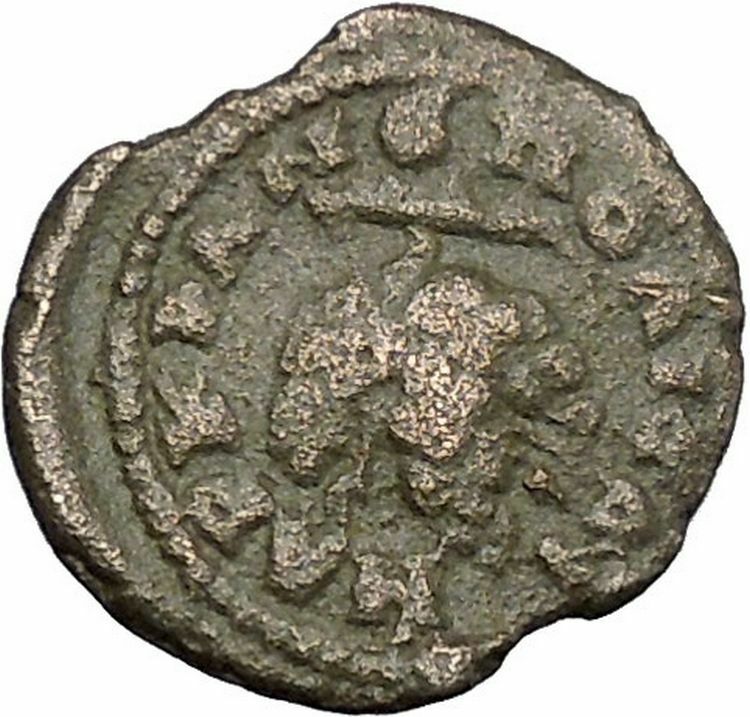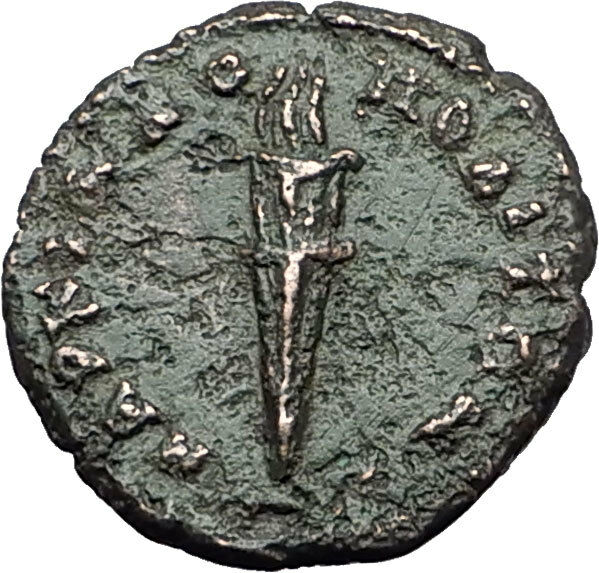|
Septimius Severus
–
Roman Emperor
: 193-211 A.D. –
Bronze 18mm (3.19 grams) of
Nicopolis ad Istrum in Moesia Inferior in Moesia Inferior 193-211 A.D.
Laureate head right.
NIKOΠOΛI ΠPOC ICTP,
Nemesis standing left holding scales and scepter
You are bidding on the exact item pictured,
provided with a Certificate of Authenticity and Lifetime Guarantee of
Authenticity.
In
Greek mythology
, Nemesis (Greek,
Νέμεσις),
also called Rhamnousia/Rhamnusia (“the
goddess
of
Rhamnous
“) at her sanctuary at
Rhamnous
, north of
Marathon
, was the spirit of divine
retribution
against those who succumb to
hubris
(arrogance before the gods). Another
name was Adrasteia, meaning “the inescapable.” The Greeks personified
vengeful fate
as a remorseless goddess: the goddess of
revenge. The name Nemesis is related to the
Greek
word νέμειν [némein], meaning “to give
what is due”.
Background
Divine retribution is a major theme in the Hellenic world view, providing the
unifying theme of the
tragedies
of
Sophocles
and many other literary works.
Hesiod
states: “Also deadly
Nyx
bore Nemesis an affliction to mortals
subject to death.” (Theogony,
223, though perhaps an interpolated line). Nemesis appears in a still more
concrete form in a fragment of the epic
Cypria
.
She is implacable justice: that of
Zeus in the
Olympian
scheme of things, although it is clear
she existed prior to him, as her images look similar to several other goddesses,
such as Cybele
,
Rhea
,
Demeter
and
Artemis
.
As the “Goddess of Rhamnous”, Nemesis was honored and placated in an archaic
sanctuary in the isolated district of Rhamnous, in northeastern
Attica
. There she was a daughter of
Oceanus
, the primeval river-ocean that
encircles the world.
Pausanias
noted her iconic statue there. It
included a crown of stags and little
Nikes
and was made by
Pheidias
after the
Battle of Marathon
(490 BC), crafted from a
block of Parian
marble
brought by the overconfident Persians,
who had intended to make a memorial
stele
after their expected victory.
Origins
Nemesis has been described as the daughter of
Oceanus
or
Zeus, but according to
Hesiod
she was a child of
Erebus
and
Nyx.
She has also been described as the daughter of Nyx alone. Her cult may have
originated at Smyrna
.
In some metaphysical mythology, Nemesis produced the egg from which hatched
two sets of twins:
Helen of Troy
and
Clytemnestra
, and the
Dioscuri
,
Castor and Pollux
. While many myths indicate
Zeus and
Leda
to be the parents of
Helen of Troy
, the author of the compilation of
myth called
Bibliotheke
notes the possibility of
Nemesis being the mother of Helen; Nemesis, to avoid Zeus, turns into a goose,
but he turns into a swan and mates with her. Nemesis in her bird form lays an
egg that is discovered in the marshes by a shepherd, who passes the egg to
Leda
. It is in this way that
Leda
comes to be the mother of
Helen of Troy
, as she kept the egg in a chest
until it hatched.
Ac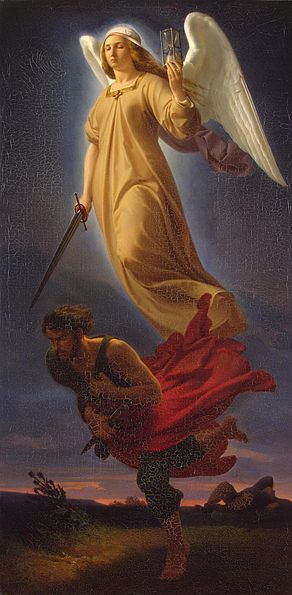 ts ts
and Deeds
Although a respected goddess, Nemesis had brought much sorrow to mortals like
Echo
and
Narcissus
. Narcissus was a very beautiful and
arrogant hunter from the territory of
Thespiae
and
Boeotia
who disdained the ones who loved him.
Nemesis lured him to a pool where he saw his own reflection in the water and
fell in love with it, not realizing it was only an image. He was unable to leave
the beauty of his reflection and he eventually died. Nemesis believed that no
one should ever have too much good, and she had always cursed those who were
blessed with countless gifts.
Fortune and
retribution
The word Nemesis originally meant the distributor of fortune, neither
good nor bad, simply in due proportion to each according to what was deserved;
then, nemesis came to suggest the resentment caused by any disturbance of
this right proportion, the sense of justice which could not allow it to pass
unpunished.
O. Gruppe
(1906) and others connect the name
with “to feel just resentment”. From the 4th century onwards, Nemesis, as the
just balancer of
Fortune
‘s chance, could be associated with
Tyche
.
In the
Greek tragedies
Nemesis appears chiefly as the
avenger of crime and the punisher of
hubris
, and as such is akin to
Atë
and the Erinyes
. She was sometimes called “Adrasteia“,
probably meaning “one from whom there is no escape”; her epithet Erinys
(“implacable”) is specially applied to Demeter and the
Phrygian
mother goddess,
Cybele
.
Local cult
A festival called Nemeseia (by some identified with the Genesia)
was held at Athens
. Its object was to avert the nemesis of
the dead, who were supposed to have the power of punishing the living, if their
cult had been in any way neglected (Sophocles,
Electra
, 792;
E. Rohde
, Psyche, 1907, i. 236, note I).
At Smyrna
there were two manifestations of
Nemesis, more akin to
Aphrodite
than to Artemis. The reason for this
duality is hard to explain; it is suggested that they represent two aspects of
the goddess, the kindly and the implacable, or the goddesses of the old city and
the new city refounded by Alexander. The martyrology Acts of
Pionius
, set in the “Decian
persecution” of AD 250–51, mentions a lapsed Smyrnan Christian who
was attending to the sacrifices at the altar of the temple of these Nemeses.
Rome
Pax-Nemesis was worshipped on occasion at
Rome by victorious generals, and in imperial times was the patroness
of gladiators
and of the venatores, who
fought in the arena with wild beasts, and was one of the
tutelary deities
of the drilling-ground (Nemesis
campestris). Sometimes, but rarely, seen on imperial coinage, mainly under
Claudius
and
Hadrian
. In the 3rd century AD there is
evidence of the belief in an all-powerful Nemesis-Fortuna. She was
worshipped by a society called Hadrian’s freedmen. The poet
Mesomedes
wrote a hymn to Nemesis in the early
2nd century CE, where he addressed her
- Nemesis, winged balancer of life,
- dark-faced goddess, daughter of Justice,
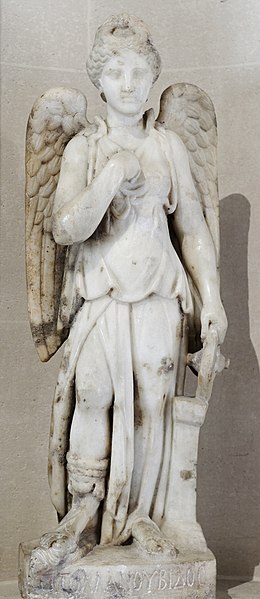
and mentioned her “adamantine bridles” that restrain “the frivolous
insolences of mortals.”
In early times the representations of Nemesis resembled Aphrodite, who
herself sometimes bears the epithet Nemesis. Later, as the maiden goddess of
proportion and the
avenger of crime
, she has as attributes a
measuring rod
(tally
stick), a
bridle
,
scales
, a
sword
and a
scourge
, and rides in a
chariot
drawn by
griffins
.
Nemesis is also known to have been called “Adrastia“.
Ammianus Marcellinus includes her in a digression on Justice following his
description of the death of Gallus Caesar.
In modern literature
Percy Jackson & the Olympians
– Nemesis
is mentioned as the goddess of revenge, and the mother of a minor
antagonist, Ethan Nakamura, who claims Nemesis traded his eye for power.
The Heroes of Olympus
– Nemesis appears
in
The Mark of Athena
, and gives
Leo Valdez
a
fortune cookie
that can solve a problem he
cannot solve on his own, for a price. She is mentioned to have a motorcycle
with
Pac-Man
-like wheels.- Project: Nemesis is about a
kaiju
who was the basis for the myth of
Nemesis. In the novel the monster is resurrected using the DNA of a murdered
girl and cuts a path of destruction to Boston so it can exact revenge on the
murderer.
- Nemesis by Agatha Christie. The main protagonist, Miss Jane Marple,
an elderly woman who often finds herself solving murders, describes herself
as ‘Nemesis’.
Nicopolis ad Istrum was a
Roman
and Early
Byzantine
town founded by Emperor
Trajan
around
101–106, at the junction of the Iatrus (Yantra)
and the Rositsa
rivers, in memory of his victory over the
Dacians
. Its
ruins are located at the village of
Nikyup
, 20 km north of
Veliko Tarnovo
in northern
Bulgaria
.
The town reached its apogee during the reigns of Trajan,
Hadrian
, the
Antonines
and the
Severan dynasty
.
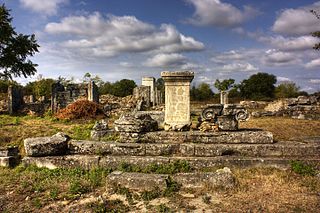
The classical town was planned according to the orthogonal system. The
network of streets, the forum surrounded by an Ionic colonnade and many
buildings, a two-nave room later turned into a basilica and other public
buildings have been uncovered. The rich architectures and sculptures show a
similarity with those of the ancient towns in Asia Minor. Nicopolis ad Istrum
had issued coins, bearing images of its own public buildings.
In
447 AD
, the town was destroyed by
Attila’s
Huns
.
Perhaps it was already abandoned before the early 400s.
In the 6th century, it was rebuilt as a powerful fortress enclosing little more
than military buildings and churches, following a very common trend for the
cities of that century in the Danube area.The largest area of the extensive ruins (21.55 hectares) of the classical
Nicopolis was not reoccupied since the fort covered only one fourth of it (5.75
hectares), in the southeastern corner.
The town became an episcopal centre during the early Byzantine period. It was
finally destroyed by the Avar invasions at the end of the 6th century. A
Bulgarian medieval settlement arose upon its ruins later (10th-14th century).
Nicopolis ad Istrum can be said to have been the birthplace of
Germanic
literary tradition. In the 4th century, the
Gothic
bishop,
missionary and translator
Ulfilas
(Wulfila)
obtained permission from Emperor
Constantius II
to immigrate with his flock of converts to Moesia and settle
near Nicopolis ad Istrum in 347-8.
There, he invented the
Gothic alphabet
and translated the
Bible
from
Greek
to
Gothic
.
L ucius Septimius Severus (or rarely Severus I) (April 11, ucius Septimius Severus (or rarely Severus I) (April 11,
145/146-February 4, 211) was a
Roman
general, and
Roman
Emperor
from April 14, 193 to 211. He was born in what is now the
Berber
part of
Rome’s historic
Africa Province
.
Septimius Severus was born and raised at
Leptis
Magna
(modern Berber
, southeast of
Carthage
,
modern Tunisia
).
Severus came from a wealthy, distinguished family of
equestrian
rank. Severus was of
Italian
Roman ancestry on his mother’s side and of
Punic
or
Libyan
-Punic[1]
ancestry on his father’s. Little is known of his father,
Publius Septimius Geta
, who held no major political status but had two
cousins who served as consuls under emperor
Antoninus Pius
. His mother, Fulvia Pia’s family moved from
Italy
to
North
Africa
and was of the
Fulvius
gens,
an ancient and politically influential clan, which was originally of
plebeian
status. His siblings were a younger
Publius Septimius Geta
and Septimia Octavilla. Severus’s maternal cousin was
Praetorian Guard
and consul
Gaius Fulvius Plautianus
.[2]
In 172, Severus was made a
Senator
by the then emperor
Marcus Aurelius
. In 187 he married secondly
Julia
Domna
. In 190 Severus became
consul
, and in
the following year received from the emperor
Commodus
(successor to Marcus Aurelius) the command of the
legions
in Pannonia
.
On the murder of
Pertinax
by
the troops in 193, they proclaimed Severus Emperor at
Carnuntum
,
whereupon he hurried to Italy. The former emperor,
Didius Julianus
, was condemned to death by the Senate and killed, and
Severus took possession of Rome without opposition.
The legions of
Syria
, however, had proclaimed
Pescennius Niger
emperor. At the same time, Severus felt it was reasonable
to offer
Clodius Albinus
, the powerful governor of Britannia who had probably
supported Didius against him, the rank of Caesar, which implied some claim to
succession. With his rearguard safe, he moved to the East and crushed Niger’s
forces at the
Battle of Issus
. The following year was devoted to suppressing Mesopotamia
and other Parthian vassals who had backed Niger. When afterwards Severus
declared openly his son
Caracalla
as successor, Albinus was hailed emperor by his troops and moved to Gallia.
Severus, after a short stay in Rome, moved northwards to meet him. On
February
19
, 197
,
in the
Battle of Lugdunum
, with an army of 100,000 men, mostly composed of
Illyrian
,
Moesian
and
Dacian
legions,
Severus defeated and killed Clodius Albinus, securing his full control over the
Empire.
Emperor
Severus was at heart a
soldier
, and
sought glory through military exploits. In 197 he waged a brief and successful
war against the
Parthian Empire
in retaliation for the support given to Pescennius Niger.
The Parthian capital
Ctesiphon
was sacked by the legions, and the northern half of
Mesopotamia
was restored to Rome.
His relations with the
Roman
Senate
were never good. He was unpopular with them from the outset, having
seized power with the help of the military, and he returned the sentiment.
Severus ordered the execution of dozens of Senators on charges of corruption and
conspiracy
against him, replacing them with his own favorites.
He also disbanded the
Praetorian Guard
and replaced it with one of his own, made up of 50,000
loyal soldiers mainly camped at
Albanum
, near Rome (also probably to grant the emperor a kind of centralized
reserve). During his reign the number of legions was also increased from 25/30
to 33. He also increased the number of auxiliary corps (numerii), many of
these troops coming from the Eastern borders. Additionally the annual wage for a
soldier was raised from 300 to 500
denarii
.
Although his actions turned Rome into a military
dictatorship
, he was popular with the citizens of Rome, having stamped out
the rampant corruption of Commodus’s reign. When he returned from his victory
over the Parthians, he erected the
Arch of Septimius Severus
in Rome.
According to Cassius Dio,[3]
however, after 197 Severus fell heavily under the influence of his Praetorian
Prefect,
Gaius Fulvius Plautianus
, who came to have almost total control of most
branches of the imperial administration. Plautianus’s daughter,
Fulvia Plautilla
, was married to Severus’s son, Caracalla. Plautianus’s
excessive power came to an end in 205, when he was denounced by the Emperor’s
dying brother and killed.[4]
The two following praefecti, including the jurist
Aemilius Papinianus
, received however even larger powers.
Campaigns in Caledonia (Scotland)
Starting from 208 Severus undertook a number of military actions in
Roman
Britain
, reconstructing
Hadrian’s Wall
and campaigning in
Scotland
.
He reached the area of the
Moray
Firth
in his last campaign in Caledonia, as was called Scotland by the
Romans.[5].
In 210 obtained a peace with the
Picts
that lasted
practically until the final withdrawal of the Roman legions from Britain
[6]
,
before falling severely ill in
Eboracum
(York).
Death
He is famously said to have given the advice to his sons: “Be harmonious,
enrich the soldiers, and scorn all other men” before he died at Eboracum on
February 4
,
211[7].
Upon his death in 211, Severus was
deified
by the Senate and succeeded by his sons,
Caracalla
and
Geta
, who were advised by his wife
Julia
Domna
.[8]
The stability Severus provided the Empire was soon gone under their reign.
Accomplishments and Record
Though his military expenditure was costly to the empire, Severus was the
strong, able ruler that Rome needed at the time. He began a tradition of
effective emperors elevated solely by the military. His policy of an expanded
and better-rewarded army was criticized by his contemporary
Dio Cassius
and
Herodianus
: in particular, they pointed out the increasing burden (in the
form of taxes and services) the civilian population had to bear to maintain the
new army.
Severus was also distinguished for his buildings. Apart from the triumphal
arch in the Roman Forum carrying his full name, he also built the
Septizodium
in Rome and enriched greatly his native city of
Leptis
Magna
(including another triumphal arch on the occasion of his visit of
203).
Severus and Christianity
Christians were
persecuted
during the reign of Septimus Severus. Severus allowed the
enforcement of policies already long-established, which meant that Roman
authorities did not intentionally seek out Christians, but when people were
accused of being Christians they could either curse
Jesus
and make an
offering to
Roman gods
, or be executed. Furthermore, wishing to strengthen the peace by
encouraging religious harmony through
syncretism
,
Severus tried to limit the spread of the two quarrelsome groups who refused to
yield to syncretism by outlawing
conversion
to Christianity or
Judaism
.
Individual officials availed themselves of the laws to proceed with rigor
against the Christians. Naturally the emperor, with his strict conception of
law, did not hinder such partial persecution, which took place in
Egypt
and the
Thebaid
, as
well as in
Africa proconsularis
and the East. Christian
martyrs
were
numerous in Alexandria
(cf.
Clement of Alexandria
, Stromata, ii. 20;
Eusebius
, Church History, V., xxvi., VI., i.). No less severe were
the persecutions in Africa, which seem to have begun in 197 or 198 (cf.
Tertullian’s
Ad martyres), and included the Christians known in the
Roman martyrology
as the martyrs of
Madaura
.
Probably in 202 or 203
Felicitas
and
Perpetua
suffered for their faith. Persecution again raged for a short time
under the proconsul
Scapula
in
211, especially in
Numidia
and
Mauritania
.
Later accounts of a Gallic
persecution, especially at
Lyon, are
legendary. In general it may thus be said that the position of the Christians
under Septimius Severus was the same as under the
Antonines
;
but the law of this Emperor at least shows clearly that the
rescript
of
Trajan
[
neededclarification] had failed to execute its purpose..
|








 ucius Septimius Severus (or rarely Severus I) (April 11,
ucius Septimius Severus (or rarely Severus I) (April 11, 
